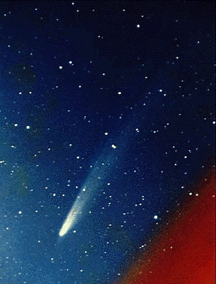Solar System Coloring Book--Comets
Location: At the outer edge of the solar system, in the Oort cloud
Number: Millions of them
Famous Comet: Halley's comet returns to Earth every 76 years.
Comets are huge dirty snowballs that are found in the farthest parts of the solar system. Comets are made of ice, dust, and small chunks of rock. Some comets come into the inner solar system every few hundred years and travel around the Sun. As they get close to the Sun, they give off gas that forms into a long tail that can reach across the sky when seen from Earth.
Other Coloring Books:
Sun | Mercury | Venus | Earth | Mars | Asteroids | Jupiter | Saturn | Uranus | Neptune | Pluto | Comets








